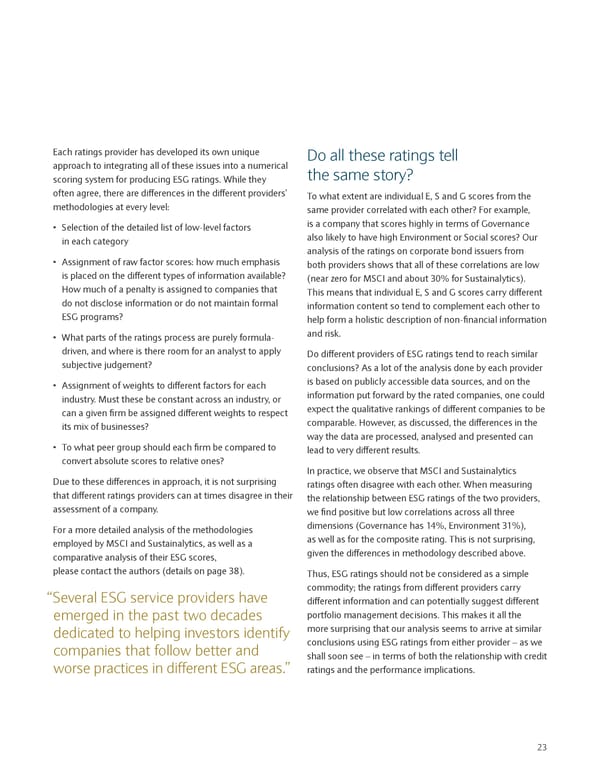Each ratings provider has developed its own unique Do all these ratings tell approach to integrating all of these issues into a numerical the same story? scoring system for producing ESG ratings. While they often agree, there are differences in the different providers’ To what extent are individual E, S and G scores from the methodologies at every level: same provider correlated with each other? For example, • Selection of the detailed list of low-level factors is a company that scores highly in terms of Governance in each category also likely to have high Environment or Social scores? Our analysis of the ratings on corporate bond issuers from • Assignment of raw factor scores: how much emphasis both providers shows that all of these correlations are low is placed on the different types of information available? (near zero for MSCI and about 30% for Sustainalytics). How much of a penalty is assigned to companies that This means that individual E, S and G scores carry different do not disclose information or do not maintain formal information content so tend to complement each other to ESG programs? help form a holistic description of non-financial information • What parts of the ratings process are purely formula- and risk. driven, and where is there room for an analyst to apply Do different providers of ESG ratings tend to reach similar subjective judgement? conclusions? As a lot of the analysis done by each provider • Assignment of weights to different factors for each is based on publicly accessible data sources, and on the industry. Must these be constant across an industry, or information put forward by the rated companies, one could can a given firm be assigned different weights to respect expect the qualitative rankings of different companies to be its mix of businesses? comparable. However, as discussed, the differences in the way the data are processed, analysed and presented can • To what peer group should each firm be compared to lead to very different results. convert absolute scores to relative ones? In practice, we observe that MSCI and Sustainalytics Due to these differences in approach, it is not surprising ratings often disagree with each other. When measuring that different ratings providers can at times disagree in their the relationship between ESG ratings of the two providers, assessment of a company. we find positive but low correlations across all three For a more detailed analysis of the methodologies dimensions (Governance has 14%, Environment 31%), employed by MSCI and Sustainalytics, as well as a as well as for the composite rating. This is not surprising, comparative analysis of their ESG scores, given the differences in methodology described above. please contact the authors (details on page 38). Thus, ESG ratings should not be considered as a simple “Several ESG service providers have commodity; the ratings from different providers carry different information and can potentially suggest different emerged in the past two decades portfolio management decisions. This makes it all the dedicated to helping investors identify more surprising that our analysis seems to arrive at similar companies that follow better and conclusions using ESG ratings from either provider – as we shall soon see – in terms of both the relationship with credit worse practices in different ESG areas.” ratings and the performance implications. 23
 Sustainable Investing and Bond Returns Page 25 Page 27
Sustainable Investing and Bond Returns Page 25 Page 27